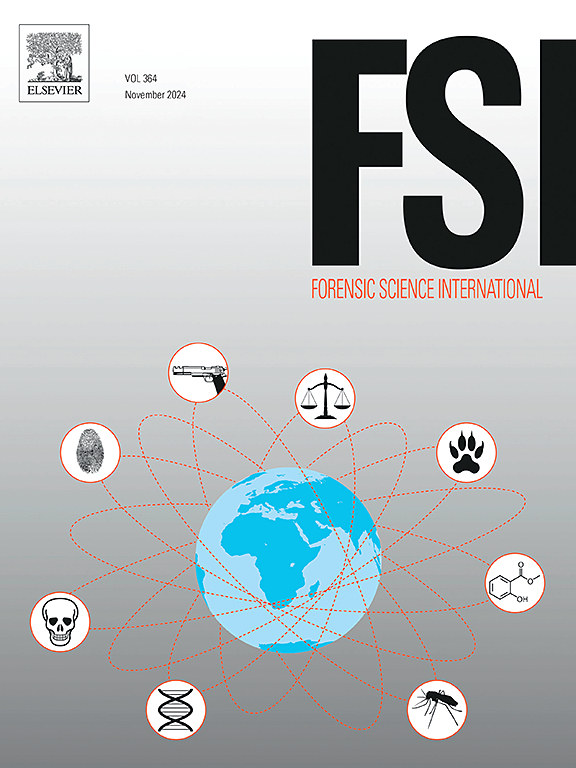Sex-estimation method for three-dimensional shapes of the skull and skull parts using machine learning
IF 2.2
3区 医学
Q1 MEDICINE, LEGAL
引用次数: 0
Abstract
Sex estimation is an indispensable test for identifying skeletal remains in the field of forensic anthropology. We developed a novel sex-estimation method for skulls and several parts of the skull using machine learning. A total of 240 skull shapes were obtained from postmortem computed tomography scans. The shapes of the whole skull, cranium, and mandible were simplified by wrapping them with virtual elastic film. These were then transformed into homologous shape models. Homologous models of the cranium and mandible were segmented into six regions containing well-known sexually dimorphic areas. Shape data were reduced in dimensionality by principal component analysis (PCA) or partial least squares regression (PLS). The components of PCA and PLS were applied to a support vector machine (SVM), and the accuracy rates of sex estimation were assessed. High accuracy rates in sex estimation were observed in SVM after reducing the dimensionality of data with PLS. The rates exceeded 90 % in two of the nine regions examined, whereas the SVM with PCA components did not reach 90 % in any region. Virtual shapes created from very large and small scores of the first principal components of PLS closely resembled masculine and feminine models created by emphasizing the shape difference between the averaged shape of male and female skulls. Such similarities were observed in all skull regions examined, particularly in sexually dimorphic areas. Estimation models also achieved high estimation accuracies in newly prepared skull shapes, suggesting that the estimation method developed here may be sufficiently applicable to actual casework.
颅骨和颅骨部分三维形状的机器学习性别估计方法
性别鉴定是法医人类学中鉴定遗骸不可缺少的方法。我们利用机器学习开发了一种新的头骨和头骨的几个部分的性别估计方法。从死后计算机断层扫描中获得了总共240个头骨形状。用虚拟弹性膜包裹整个颅骨、头盖骨和下颌骨,简化了它们的形状。然后将它们转换成相应的形状模型。颅骨和下颌骨的同源模型被分割成六个区域,其中包含众所周知的两性二型区。通过主成分分析(PCA)或偏最小二乘回归(PLS)对形状数据进行降维。将PCA和PLS的分量应用到支持向量机(SVM)中,评估性别估计的正确率。在用PLS对数据降维后,SVM的性别估计准确率很高,在9个区域中有2个区域的准确率超过90 %,而含有PCA成分的SVM在任何区域都没有达到90 %。通过强调男性和女性头骨的平均形状之间的形状差异,从PLS的第一主成分的非常大和小的分数创建的虚拟形状非常类似于男性和女性模型。这种相似性在所有被检查的颅骨区域都被观察到,特别是在两性二态区。估计模型在新制备的头骨形状中也取得了很高的估计精度,表明本文开发的估计方法可能足以适用于实际案例。
本文章由计算机程序翻译,如有差异,请以英文原文为准。
求助全文
约1分钟内获得全文
求助全文
来源期刊

Forensic science international
医学-医学:法
CiteScore
5.00
自引率
9.10%
发文量
285
审稿时长
49 days
期刊介绍:
Forensic Science International is the flagship journal in the prestigious Forensic Science International family, publishing the most innovative, cutting-edge, and influential contributions across the forensic sciences. Fields include: forensic pathology and histochemistry, chemistry, biochemistry and toxicology, biology, serology, odontology, psychiatry, anthropology, digital forensics, the physical sciences, firearms, and document examination, as well as investigations of value to public health in its broadest sense, and the important marginal area where science and medicine interact with the law.
The journal publishes:
Case Reports
Commentaries
Letters to the Editor
Original Research Papers (Regular Papers)
Rapid Communications
Review Articles
Technical Notes.
 求助内容:
求助内容: 应助结果提醒方式:
应助结果提醒方式:


